|
1-
Introduction
2 -
The Liberal Government's Warm Embrace of
Ukraine's Nazi Collaborators
3 -
Historical Amnesia and the Blinding
Effects of Propaganda
4 -
The Nazis as Victims? Sure, just Blame the
Russians!
5 -
Canada needs Truth and Reconciliation, not
Denials and Obfuscation
6 -
Historical Denial among Canada's
ultranationalist Ukrainians
7 -
Michael Chomiak, The Ukrainian Central
Committee and its Nazi Newspapers
8 -
Aryanisation and the "Mighty Wurlitzer"
9 -
The
Ukrainian Canadian Congress and its Fascist Roots
10 -
Getting them Early: Building the
ultraNationalist Cause among
Children and Youth
11 -
The Freeland-Chomiak Parallels in Advocacy
Journalism
12 -
Was Freeland an "Accidental Journalist," or Groomed for the
Job?
13 -
In 1989, Freeland was Declared an "Enemy of
the Soviet State"
14 -
A Chomiak-Freeland Fixation on Jewish
Oligarchs running the Kremlin
15 -
Freeland's Kremlin-Oligarch Theory goes
Global with Jewish Plutarchetype
16 -
Institutionalised Confidence Scams: An Open
Conspiracy of Oligarchs, Politicians and Journalists
17 -
Escaping the War Racket starts with Seeing
the Elephant
18 -
Just Following Orders? Which Orders?
19 -
Is there a Bear in the Room? Kill it!
20 -
The Collective Care and Feeding of
Russophobia
21 -
The Need for Truth and Reconciliation
Ukrainian War Veterans
Associations
as "National Member"
organisations
of the Ukrainian Canadian
Congress
Between 2010 and 2016, the UCC's online web listing of national member
groups included two Ukrainian-Canadian veterans groups:
(1) the “Society
of Veterans of Ukrainian Insurgent Army–UPA" (led by Stepan Bandera) and
(2) the “Brotherhood of Veterans 1st Division UNA [Ukrainian National
Army] National HQ." This latter name is a euphemism adopted in the very
last few days of WWII. Its troops never fought using this name but
changed it only when it became obvious the war was over. This Ukrainian
division actually fought as the Nazi's 14th Division Waffen SS Galicia.
As can be seen from the Internet Archive, these two veterans groups were
removed from the UCC's online membership list sometime between May 8,
2016 and Oct 7, 2016. This occurred not long after my research (in Captive
Canada)
drew attention to the fact that their
names were on the UCC's member list.
See Internet Archive of the UCC webpage listing national members
organisations. The symbols below are (1) the flag of Bandera's UPA and
(2) the crest of the Waffen SS Galician Division:
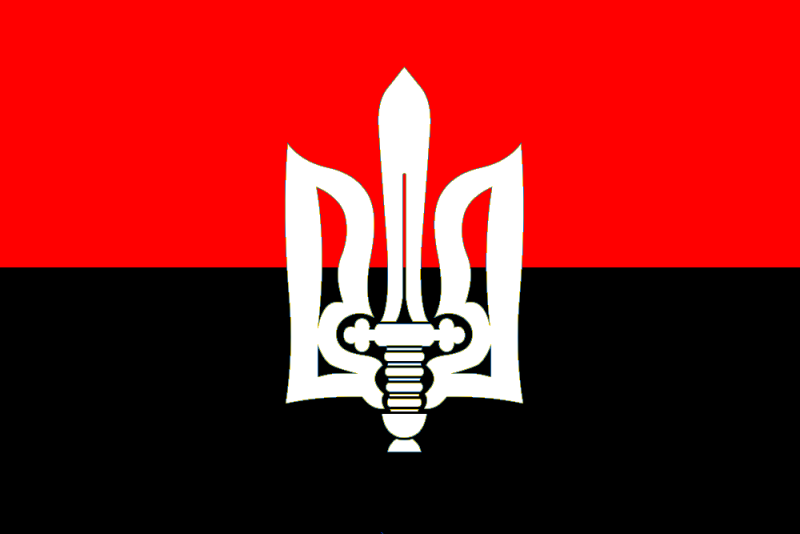
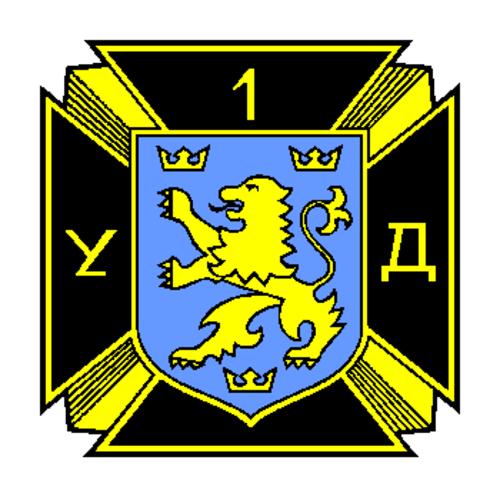
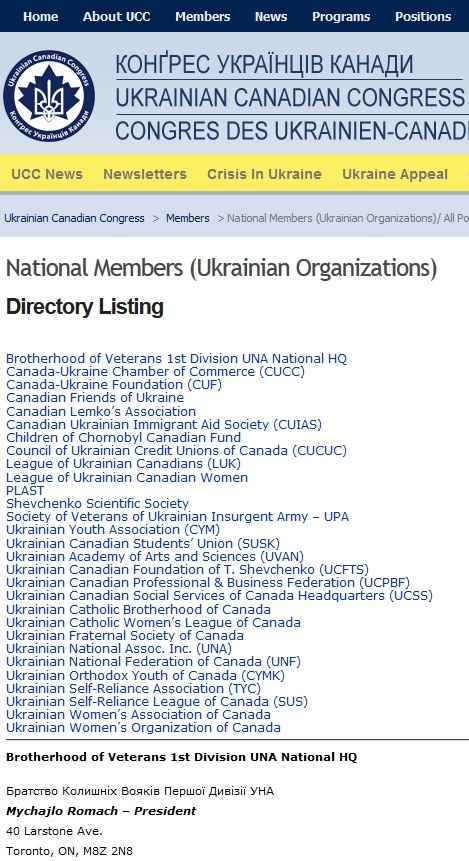
The above UCC "National Members" list is from June 8, 2016.
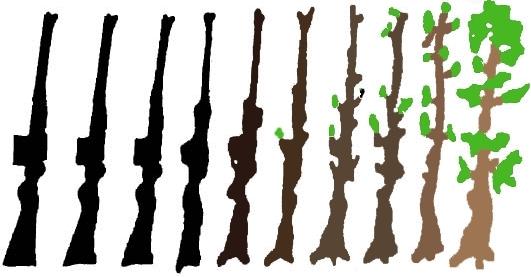
Press for Conversion!
If you appreciate the work that went into this research, please
subscribe &/or donate.
You can mail this
coupon
to COAT, or use the
Paypal link
on our homepage. Subscription prices:
3 issues ($25), 6 issues ($45).
Subscribe now and get this 56-page issue
for free, or order it for $10.
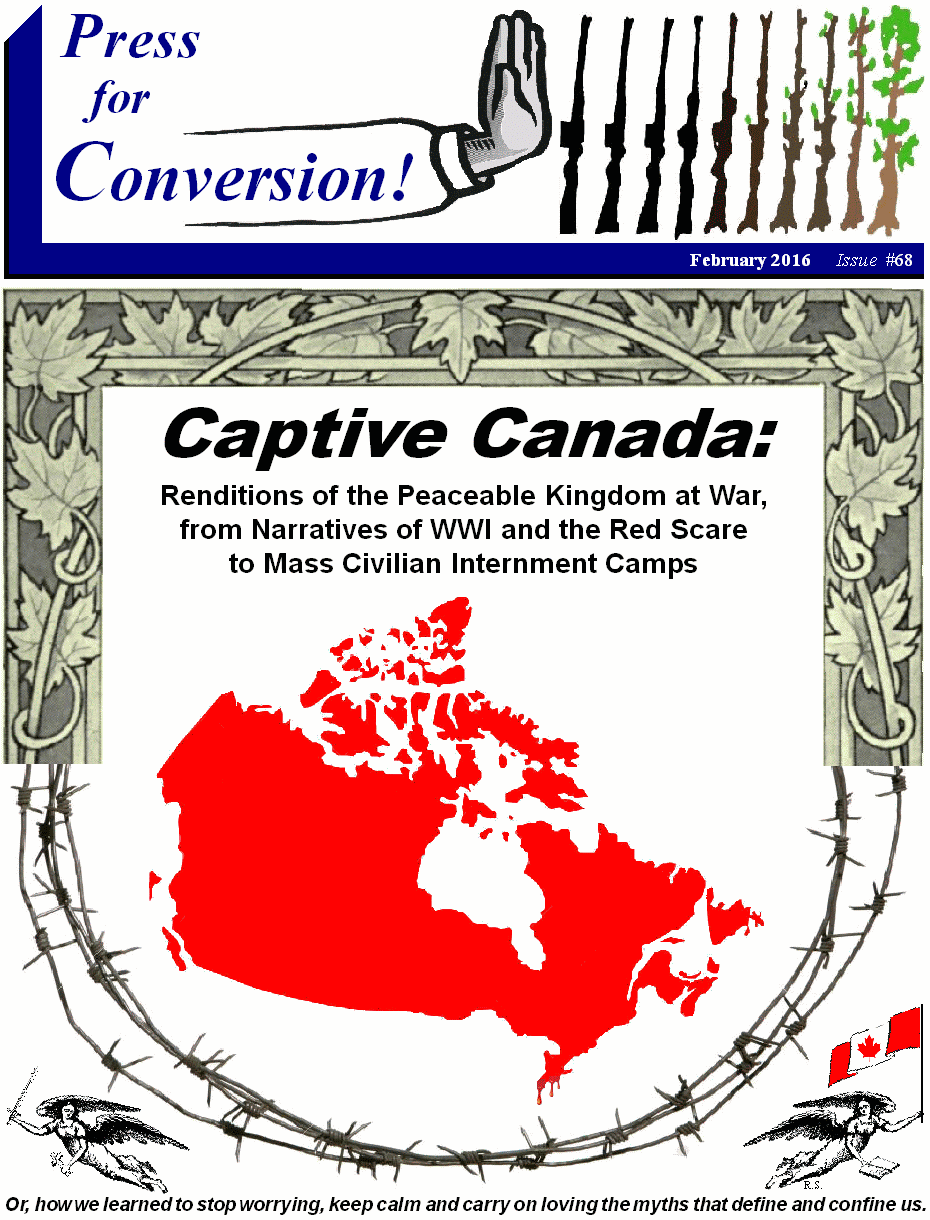
Captive
Canada:
Renditions of the Peaceable Kingdom at War, from
Narratives of WWI and the Red Scare to the Mass Internment of Civilians
Or, how we learned to stop worrying, keep calm and carry on loving the myths that define and confine us.
This issue (#68) deals with the mass internment of Ukrainian Canadians, this
community's left-right split and the mainstream racist, xenophobic
anti-communism of progressive "Social Gospellers" (like the CCF's J.S.
Woodsworth) who were so captivated by their false beliefs that they
carried out the genocide of First Nations and turned a blind eye to
government repression during the 20th-century "Red Scare."
The main thesis is captured here:
"The
Canada Syndrome,
a Captivating Mass Psychosis"
|
Part 9
The Ukrainian Canadian
Congress and its Fascist Roots
Since the war, the dominant voices of obfuscation and denial regarding the
well-documented history of Nazi-Ukrainian collaboration have been closely
affiliated with, and often led by, an organisation called the Ukrainian
Canadian Congress.[i]
Its creation in 1940 was actually facilitated by the Liberal government.
Their explicit goal in orchestrating the creation of this umbrella
organisation was to rally all anticommunist Ukrainians into one body in
order to squash the then-powerful influence of leftwing Ukrainians whose
forebears had come to Canada during earlier waves of migration. We should
not forget that communism was illegal at that time and was officially
targeted for repression in Canada throughout most of the 20th century.
After WWII, despite opposition from the Canadian Jewish Congress and
progressive Ukrainian socialists and communists, the Ukrainian Canadian
Congress (UCC) supported the Liberal government in welcoming thousands of
Ukrainian veterans who had volunteered to support the Nazi cause. The UCC
and its "strictly anti-Communistic" views were "very much strengthened by
the new mass immigration (1945-1951), when more than 35,000 Ukrainian
Displaced Persons arrived from Europe."[ii]
These militantly patriotic Ukrainians ‑ like Michael Chomiak and his family
‑ swelled the ranks of existing Canadian émigré groups. They also formed
veterans' associations, were assisted by the Canadian government in founding
and sustaining ultrarightwing media platforms, and took leadership positions
in social, religious and political organisations that still comprise the
backbone of the UCC.
Over the decades, the UCC benefited from
the dedicated activism of Ukrainian patriots like Michael Chomiak and his
granddaughter Chrystia Freeland. Chomiak was involved in a variety of
ultranationalist groups linked to the UCC. In the biographical notes
compiled by the Alberta Archives, Chomiak is described as having "served on
the boards of many Ukrainian organizations." His personal files, now housed
in those archives, include materials on the UCC, as well as numerous of its
member groups.[iii]
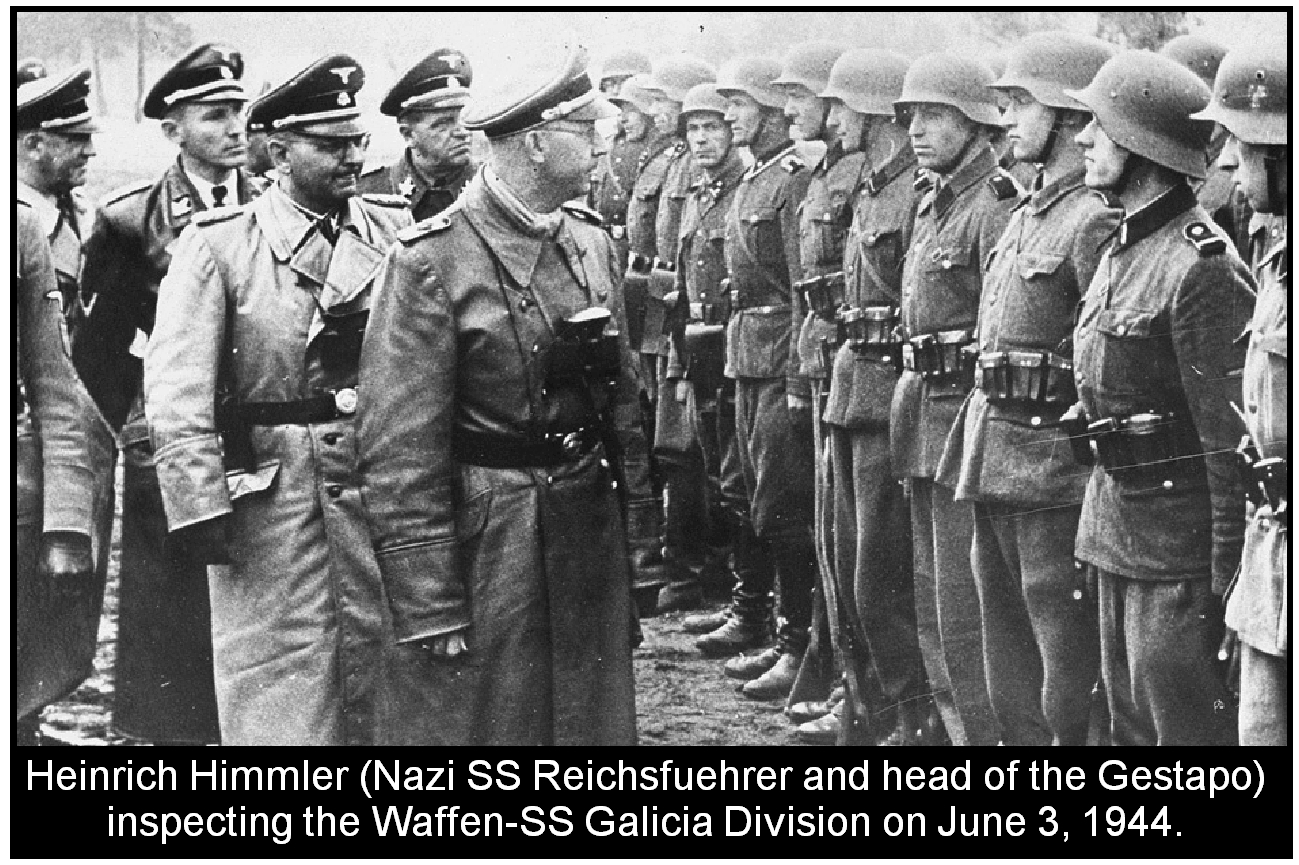 However, not listed in the archive's
biography of Chomiak was any reference to his role as a highly-respected
figure among various Ukrainian WWII veterans' associations in Edmonton
including the Waffen SS Galicia.[iv]
Until just last summer, this association of Nazi SS soldiers was openly
listed on the UCC website as one of its national member organisations.[v]
The Ukrainian SS is still given a prominent place of honour at some UCC
events. For example, at UCC Edmonton's annual commemoration of the Holodomor
in 2016, a Ukrainian WWII veteran stood behind the speaker's podium holding
the infamous Waffen SS flag.[vi] However, not listed in the archive's
biography of Chomiak was any reference to his role as a highly-respected
figure among various Ukrainian WWII veterans' associations in Edmonton
including the Waffen SS Galicia.[iv]
Until just last summer, this association of Nazi SS soldiers was openly
listed on the UCC website as one of its national member organisations.[v]
The Ukrainian SS is still given a prominent place of honour at some UCC
events. For example, at UCC Edmonton's annual commemoration of the Holodomor
in 2016, a Ukrainian WWII veteran stood behind the speaker's podium holding
the infamous Waffen SS flag.[vi]
 The UCC has even lobbied the government "to
make changes to Canada's War Veterans Allowance Act by expanding eligibility
to include designated resistance groups such as OUN-UPA."[vii]
The UPA or Ukrainian Insurgent Army, is another member group of the UCC. It
too was a fascist, and extremely racist, antiSemitic military formation.
Its leader, Stepan Bandera is still revered by those who ally themselves
with his faction of the Organisation of Ukrainian Nationalists, i.e., the
OUN(B). (See its logo, at right.) Like the Waffen SS Galicia, it too collaborated with the Nazis and
was involved in the mass murder of Jews, Poles and Soviets.[viii]
In the trial of Nazi war criminals at Nuremberg, testimony was submitted
from Abwehr Colonel
Erwin Stolze
that both leaders of the OUN --
Andriy
Melnyk and Stepan Bandera -- were "German Agents." (The
Trial of German Major War Criminals,
February 11, 1946, p.252.) The UCC has even lobbied the government "to
make changes to Canada's War Veterans Allowance Act by expanding eligibility
to include designated resistance groups such as OUN-UPA."[vii]
The UPA or Ukrainian Insurgent Army, is another member group of the UCC. It
too was a fascist, and extremely racist, antiSemitic military formation.
Its leader, Stepan Bandera is still revered by those who ally themselves
with his faction of the Organisation of Ukrainian Nationalists, i.e., the
OUN(B). (See its logo, at right.) Like the Waffen SS Galicia, it too collaborated with the Nazis and
was involved in the mass murder of Jews, Poles and Soviets.[viii]
In the trial of Nazi war criminals at Nuremberg, testimony was submitted
from Abwehr Colonel
Erwin Stolze
that both leaders of the OUN --
Andriy
Melnyk and Stepan Bandera -- were "German Agents." (The
Trial of German Major War Criminals,
February 11, 1946, p.252.)
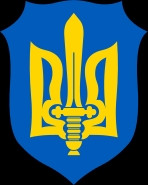 In
1940, the OUN split into two factions, the OUN(B), led by Bandera, and the
OUN-M, led by Melnyk (See the latter's logo, at right.). Both
organisations were fascist, antiSemitic and extremely anticommunist. Both
factions established their own organisations in Canada that worked under the
banner of the government-supported UCC. During the war, the German
authorities had also worked with both OUN factions, although they preferred
the Melnykite's of Kubijovych's Ukrainian Central Committee. The
Nazi's perceived that the OUN(M) was more manageable and willing to follow
their directives than the OUN(B). In
1940, the OUN split into two factions, the OUN(B), led by Bandera, and the
OUN-M, led by Melnyk (See the latter's logo, at right.). Both
organisations were fascist, antiSemitic and extremely anticommunist. Both
factions established their own organisations in Canada that worked under the
banner of the government-supported UCC. During the war, the German
authorities had also worked with both OUN factions, although they preferred
the Melnykite's of Kubijovych's Ukrainian Central Committee. The
Nazi's perceived that the OUN(M) was more manageable and willing to follow
their directives than the OUN(B).
During the first two years
following the Nazi invasion of Ukraine (June 1941-June 1943), the Nazis
massacred about 500,000 Jews in Eastern Galicia and 200,000 in Volhynia.
Although this represented 90% of the Jewish population in these areas when
the Germans arrived, almost a million Ukrainian Jews were lucky to escape to
the USSR with the retreating Soviet Army when the Nazi invasion began.
Taking part in the mass murders which occurred during the early weeks of the
Nazi invasion, were special militia units created by the OUN(B). These
units collaborated with Wehrmacht in carrying out pogroms against Jews
between June 22 and the end of July 1941.
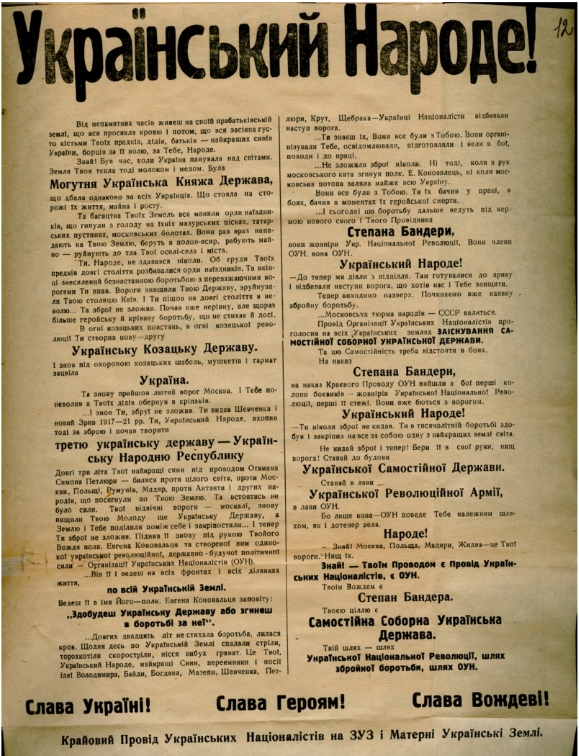 When the Nazis occupied Lviv on
June 30, 1941, the OUN(B), declared Ukraine's independence and posted these notices
all around the city (see image at left). The notice stated in part: When the Nazis occupied Lviv on
June 30, 1941, the OUN(B), declared Ukraine's independence and posted these notices
all around the city (see image at left). The notice stated in part:
“Do not throw
away your weapons now. Take them in your hands. Destroy the enemy.…
"People!
Know! Moscow, Poland, the Hungarians, the Jews are your enemies. Destroy them!
"Know! Your leadership is the Leadership of Ukrainian Nationalists, is the
OUN. Your Leader is Stepan Bandera. Your goal is an Independent
United Ukrainian State. Your path is the path of the Ukrainian National
Revolution, the path of armed struggle, the path of the OUN.
"Glory to Ukraine!
Glory to the Heroes! Glory to the Leader!”[ix]
Pogroms to kill Jews began the next day and a vivid description of them has survived.[x]
As an outspoken promoter of
ultranationalist Ukrainian politics, Freeland has not only carefully avoided
any public reference to her grandfather's wartime propaganda work for the
Nazis, she has also steered publicly clear of the whole issue of
Nazi-Ukrainian collaboration in general.
Freeland's effective, high-profile
activism on behalf of her Ukrainian community has not gone unnoticed by the UCC. In fact, the UCC has often used its publications, events and internet
presence to draw prideful attention to the key milestones in Freeland's
career. She is now the highest-profile representative of the UCC and the
extremely nationalist Ukrainian political brand that it represents. As such,
Freeland has gladly offered her services to be a figurehead in Toronto's
huge Ukrainian parade,[xi]
and has been the keynote speaker and moderator at some of the UCC's largest
recent events.[xii]
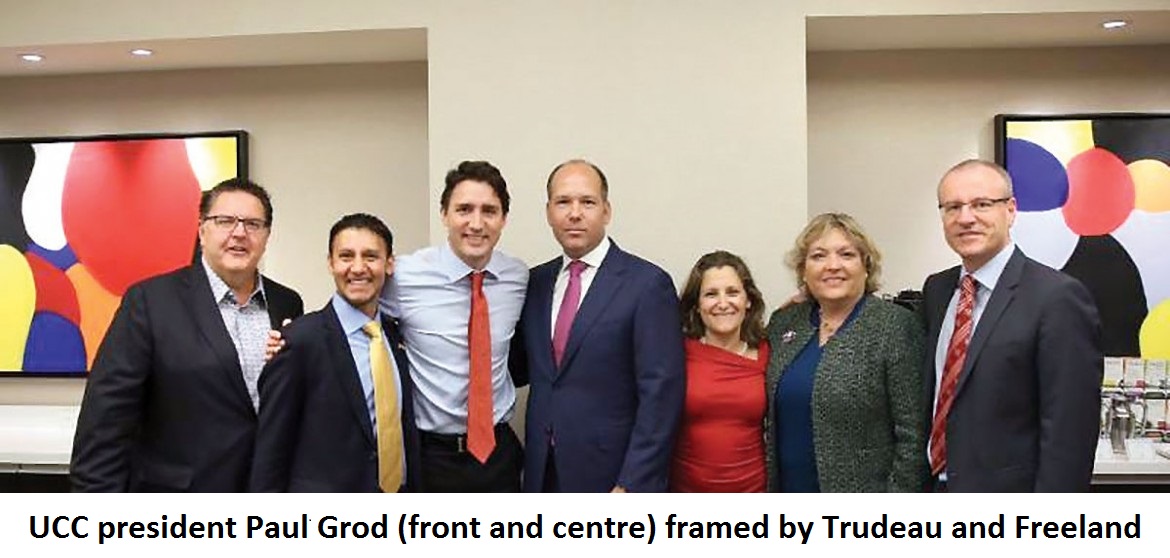
UCC president Paul Grod is someone who
Freeland fondly describes as a "friend."[xiii]
He is among those UCC leaders affiliated with organisations that count
Stepan Bandera among their greatest national heroes. Freeland too considers
Bandera someone worth commemorating. She has described him as a "western
Ukrainian partisan leader ... who led a guerrilla war against the Nazis and
the Soviets and was poisoned on orders from Moscow in 1959...." She also
noted that in "eastern Ukraine," where many ethnic Russians live, "the
Soviet portrayal of Bandera as a traitor still lingers."[xiv]
The CIA, which was happy to employ
Ukrainian fascists like the Banderites to continue their armed struggle
against the USSR for several years after WWII ended, described Bandera as a
"leader ... and symbol of the most violent, twentieth century, western
Ukrainian political movement: the Organization of Ukrainian Nationalists [OUN],
which in late 1942 and early 1943 formed the Ukrainian Insurgent Army [UPA]."[xv]
Another formerly-secret CIA document summed up Bandera's OUN(B) faction, by
saying it:
"is based on principles ... such as
dictatorial rule, veneration of the leader, blind fulfillment of
instructions, and intolerance of contrary opinion. Totalitarian tendencies
are evident in that organization's efforts to control every aspect of émigré
life, in its unbridled use of slander and calumny, and in frequent use of
threats and outright terror."[xvi]
Canadian Banderites and their organisations
have dominated the UCC's leadership for some 20 years. The OUN(B) in Canada
is organised primarily through the League of Ukrainian Canadians (LUC),
whose publication Homin Ukrainy (Ukrainian Echo) is published
in Toronto.[xvii]
Between 1960 and 2013 the hub of the ultranationalist Ukrainian community in
Toronto was the Ukrainian Cultural Centre (83-85
Christie St.). It housed the offices of the Ukrainian
Echo and the Ukrainian Youth Association of Canada.
Here is a photo from a performance at their Cultural Centre in Toronto. Note
that a large portrait of Stepan Bandera is used as a stage backdrop:

The LUC's major national affiliates include the League of Ukrainian Canadian Women, the
Society of Veterans of the UPA and the the
Ukrainian Youth Association.
[xviii]
The latter is basically Canada's Bandera youth
association, a scouting organisation (similar in military structure and
appearance to the one set up by British imperialist Lt.Gen. and Baron,
Sir Robert Baden-Powell).
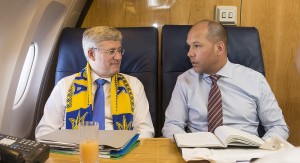 A leading figure of the Bandera youth
association is UCC president Paul Grod. In 2013, when
Grod was a key speaker at the Ukrainian Youth Association's 30th triennial meeting in Etobicoke Ontario,
he posed front and centre with about 100 uniformed representatives of the
Bandera youth who gathered from across Canada. A leading figure of the Bandera youth
association is UCC president Paul Grod. In 2013, when
Grod was a key speaker at the Ukrainian Youth Association's 30th triennial meeting in Etobicoke Ontario,
he posed front and centre with about 100 uniformed representatives of the
Bandera youth who gathered from across Canada.

 In
the group
photo (above) Grod and company were flanked by portraits of Queen Elisabeth and Stepan Bandera.[xix]
Other photos from this collection show smiling youth holding meetings under
a portrait of OUN(B) chairman Yaroslav Stetsko, who was Bandera's right hand
man.[xx]
After
Bandera's death, Stetsko led the OUN(B) between 1968 and 1986.
Stetsko also led a CIA-supported, fascist organisation called
Anti-Bolshevik Bloc of Nations between 1946 and 1986.[xxi] In
the group
photo (above) Grod and company were flanked by portraits of Queen Elisabeth and Stepan Bandera.[xix]
Other photos from this collection show smiling youth holding meetings under
a portrait of OUN(B) chairman Yaroslav Stetsko, who was Bandera's right hand
man.[xx]
After
Bandera's death, Stetsko led the OUN(B) between 1968 and 1986.
Stetsko also led a CIA-supported, fascist organisation called
Anti-Bolshevik Bloc of Nations between 1946 and 1986.[xxi]

In 2012, the OUN(B)'s youth
organisation commemorated an anniversary of chairman Stetsko.
Photographs of this event show uniform-wearing Ukrainian-Canadian children
marching in formation reverently carrying Stetsko's portrait. Other
children in the formation are shown carrying Canadian and Ukrainian
flags, and the red and black battle flag of Bandera's army, the UPA.[xxii]
 Yaroslav Stetsko's 1941 autobiography summed up some
of OUN(B)'s extremist beliefs about their prime enemies, the Jews and
communists. Their fascist ideology closely coincides with the Nazi
ideologies promulgated in Krakivs'ki visti. Here is an excerpt from
Stetsko's autobiography which illustrates his endorsement of Nazi methods
for "exterminating Jewry in Ukraine": Yaroslav Stetsko's 1941 autobiography summed up some
of OUN(B)'s extremist beliefs about their prime enemies, the Jews and
communists. Their fascist ideology closely coincides with the Nazi
ideologies promulgated in Krakivs'ki visti. Here is an excerpt from
Stetsko's autobiography which illustrates his endorsement of Nazi methods
for "exterminating Jewry in Ukraine":
"I
consider Marxism to be a product of the
Jewish mind, which, however, has been applied in the Muscovite prison of
peoples by the Muscovite-Asiatic people with the assistance of Jews.
Moscow and Jewry are Ukraine's greatest enemies and bearers of corruptive
Bolshevik international ideas.
I ... fully appreciate the undeniably harmful and hostile role of the Jews,
who are helping Moscow to enslave Ukraine.
I therefore
support the
destruction
of the Jews and the expedience of bringing German methods of exterminating
Jewry to Ukraine,
barring their assimilation and the like."[xxiii]
(Emphasis added.)
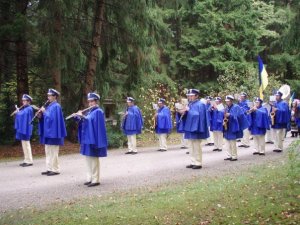 The
OUN(B)'s Bandera youth movement has branches across Canada but they also
exist in Australia, Argentina, Germany, the UK, the US and Ukraine.
These national branches have regular international meetings. For example in
2009 their World Executive Committee met in Munich, Germany. They were
preparing for the 8th World Meeting of youth affiliates of the
OUN(B) which was held in Vancouver in 2010
to coincide with the Winter Olympics. The
OUN(B)'s Bandera youth movement has branches across Canada but they also
exist in Australia, Argentina, Germany, the UK, the US and Ukraine.
These national branches have regular international meetings. For example in
2009 their World Executive Committee met in Munich, Germany. They were
preparing for the 8th World Meeting of youth affiliates of the
OUN(B) which was held in Vancouver in 2010
to coincide with the Winter Olympics.
The Munich meeting was timed to coincide
with the 100th birthday of Stepan Bandera on October 17, 2009. On that
day Bandera youth joined with other Ukrainians who had made the pilgrimage
to march to Bandera's tomb at
Waldfriedhof. At this solemn event
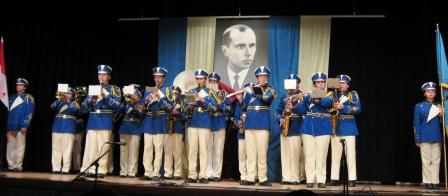 wreaths
and flowers were laid in the presence of Ukrainian religious leaders.
Toronto's Baturyn Marching
Band was also there. (See photos at left and above.) For fifty
years, this Ukrainian Youth Association band has been performing at
Ukrainian festivals and events across Canada, and in the US and Europe . wreaths
and flowers were laid in the presence of Ukrainian religious leaders.
Toronto's Baturyn Marching
Band was also there. (See photos at left and above.) For fifty
years, this Ukrainian Youth Association band has been performing at
Ukrainian festivals and events across Canada, and in the US and Europe .
 On
the
evening of the march to Bandera's tomb, they held a large event to
commemorate Bandera's 100th birthday celebrated by youth groups from various
countries which performed patriot Ukrainian songs to honour their nation,
their leader and their cause. Among them were the Baturyn band and the
Bandera movement choir from Canada, the Prolisok Youth Ensemble (See photo
at right, with the large portrait of Bandera as the stage backdrop. Click
any of these three photographs to see the Google's translation of the
website of Germany
Bandera youth movement
which hosted the international meeting in 2009. On
the
evening of the march to Bandera's tomb, they held a large event to
commemorate Bandera's 100th birthday celebrated by youth groups from various
countries which performed patriot Ukrainian songs to honour their nation,
their leader and their cause. Among them were the Baturyn band and the
Bandera movement choir from Canada, the Prolisok Youth Ensemble (See photo
at right, with the large portrait of Bandera as the stage backdrop. Click
any of these three photographs to see the Google's translation of the
website of Germany
Bandera youth movement
which hosted the international meeting in 2009.
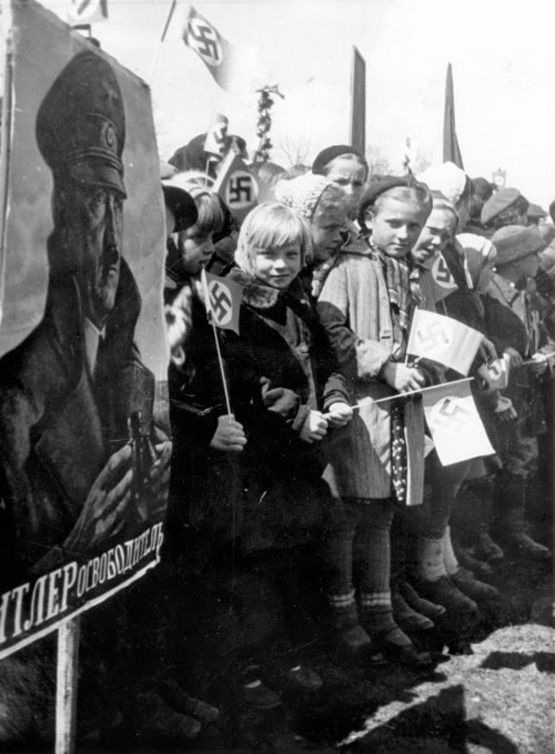 Most of those involved in the OUN(B)'s
Bandera youth association are likely unaware that their revered leaders were
ardent supporters of, and deeply complicit in, the mass murder of Jews,
Poles and communists. Many young Banderites would likely be shocked to
hear such facts and might therefore reasonably respond by categorically
denying the information as "fake news." Most of those involved in the OUN(B)'s
Bandera youth association are likely unaware that their revered leaders were
ardent supporters of, and deeply complicit in, the mass murder of Jews,
Poles and communists. Many young Banderites would likely be shocked to
hear such facts and might therefore reasonably respond by categorically
denying the information as "fake news."
They might even allege that anyone making such "allegations" had been duped
by the Russians.
(Continue
reading this article)
(The wartime photo at left shows Ukrainian
children with swastika flags and a Hitler poster welcoming a parade of
Nazi soldiers.)
|
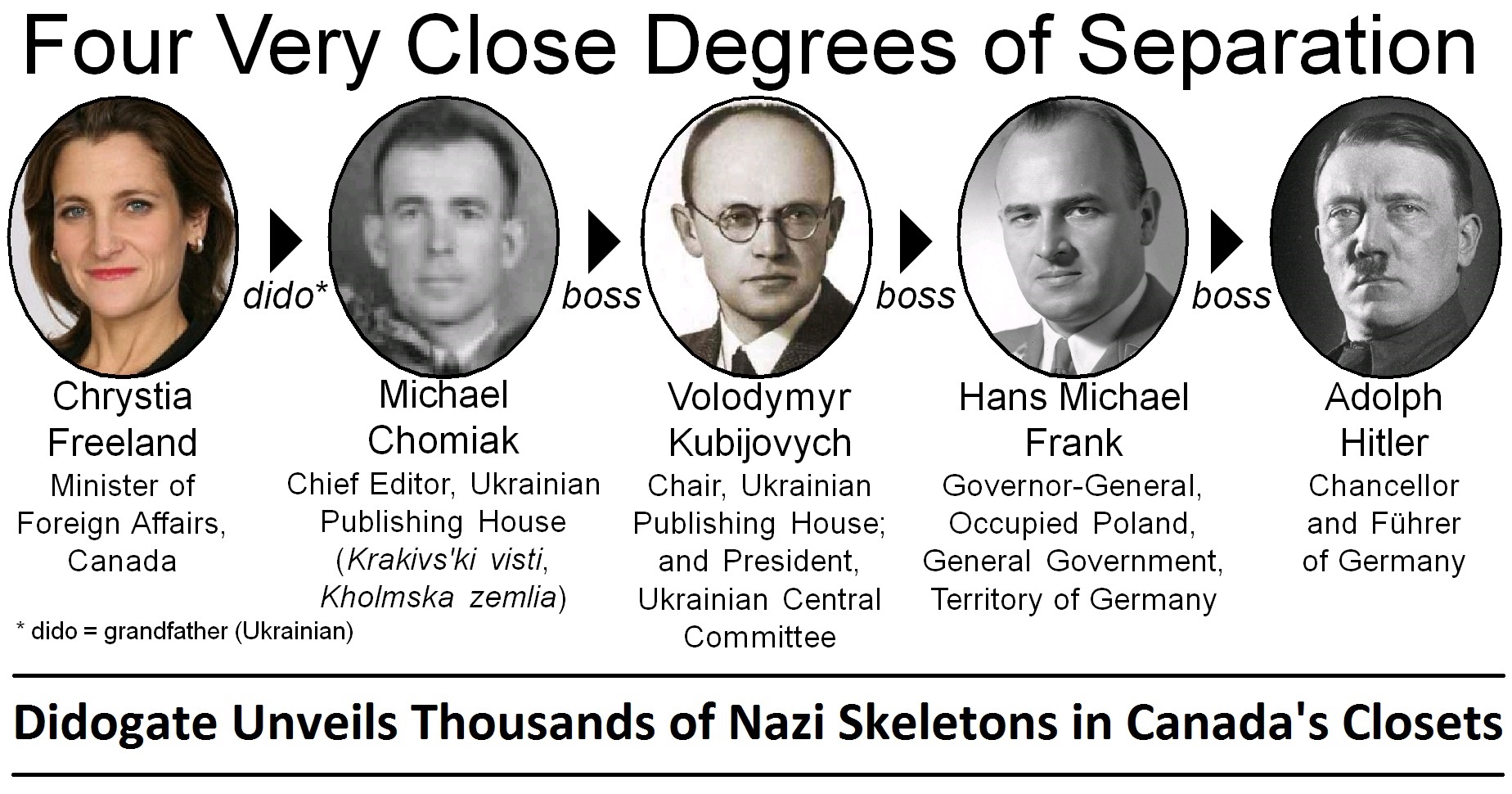




 However, not listed in the archive's
biography of Chomiak was any reference to his role as a highly-respected
figure among various Ukrainian WWII veterans' associations in Edmonton
including the Waffen SS Galicia.
However, not listed in the archive's
biography of Chomiak was any reference to his role as a highly-respected
figure among various Ukrainian WWII veterans' associations in Edmonton
including the Waffen SS Galicia. The UCC has even lobbied the government "to
make changes to Canada's War Veterans Allowance Act by expanding eligibility
to include designated resistance groups such as OUN-UPA."
The UCC has even lobbied the government "to
make changes to Canada's War Veterans Allowance Act by expanding eligibility
to include designated resistance groups such as OUN-UPA." In
1940, the OUN split into two factions, the OUN(B), led by Bandera, and the
OUN-M, led by Melnyk (See the latter's logo, at right.). Both
organisations were fascist, antiSemitic and extremely anticommunist. Both
factions established their own organisations in Canada that worked under the
banner of the government-supported UCC. During the war, the German
authorities had also worked with both OUN factions, although they preferred
the Melnykite's of Kubijovych's Ukrainian Central Committee. The
Nazi's perceived that the OUN(M) was more manageable and willing to follow
their directives than the OUN(B).
In
1940, the OUN split into two factions, the OUN(B), led by Bandera, and the
OUN-M, led by Melnyk (See the latter's logo, at right.). Both
organisations were fascist, antiSemitic and extremely anticommunist. Both
factions established their own organisations in Canada that worked under the
banner of the government-supported UCC. During the war, the German
authorities had also worked with both OUN factions, although they preferred
the Melnykite's of Kubijovych's Ukrainian Central Committee. The
Nazi's perceived that the OUN(M) was more manageable and willing to follow
their directives than the OUN(B).  When the Nazis occupied Lviv on
June 30, 1941, the OUN(B), declared Ukraine's independence and posted these notices
all around the city (see image at left). The notice stated in part:
When the Nazis occupied Lviv on
June 30, 1941, the OUN(B), declared Ukraine's independence and posted these notices
all around the city (see image at left). The notice stated in part: 

 A leading figure of the Bandera youth
association is UCC president Paul Grod. In 2013, when
Grod was a key speaker at the Ukrainian Youth Association's 30th triennial meeting in Etobicoke Ontario,
he posed front and centre with about 100 uniformed representatives of the
Bandera youth who gathered from across Canada.
A leading figure of the Bandera youth
association is UCC president Paul Grod. In 2013, when
Grod was a key speaker at the Ukrainian Youth Association's 30th triennial meeting in Etobicoke Ontario,
he posed front and centre with about 100 uniformed representatives of the
Bandera youth who gathered from across Canada. 
 In
the group
photo (above) Grod and company were flanked by portraits of Queen Elisabeth and Stepan Bandera.
In
the group
photo (above) Grod and company were flanked by portraits of Queen Elisabeth and Stepan Bandera.




 Most of those involved in the OUN(B)'s
Bandera youth association are likely unaware that their revered leaders were
ardent supporters of, and deeply complicit in, the mass murder of Jews,
Poles and communists. Many young Banderites would likely be shocked to
hear such facts and might therefore reasonably respond by categorically
denying the information as "fake news."
Most of those involved in the OUN(B)'s
Bandera youth association are likely unaware that their revered leaders were
ardent supporters of, and deeply complicit in, the mass murder of Jews,
Poles and communists. Many young Banderites would likely be shocked to
hear such facts and might therefore reasonably respond by categorically
denying the information as "fake news."